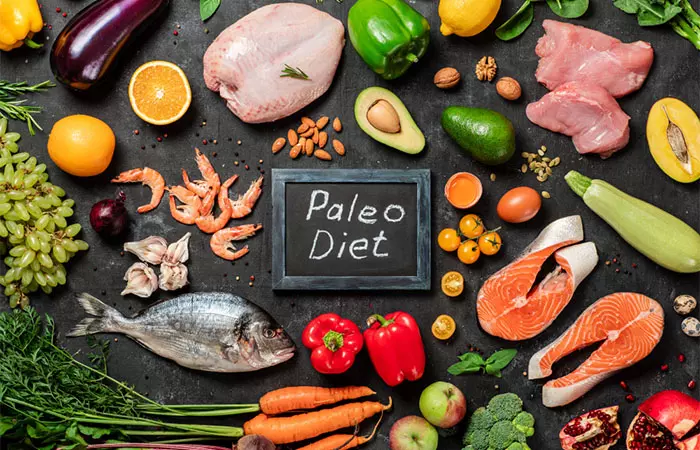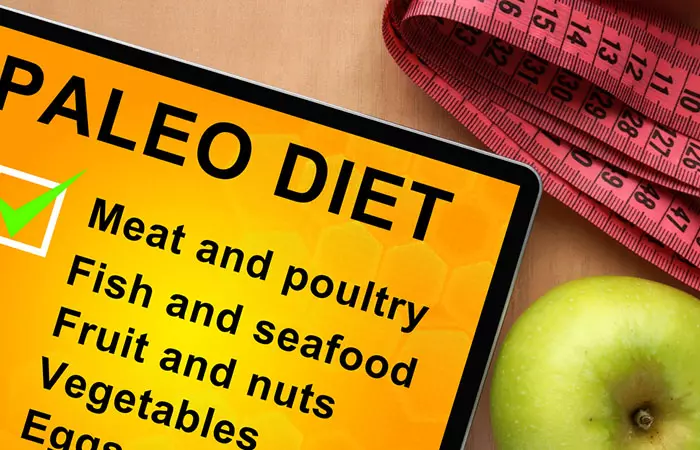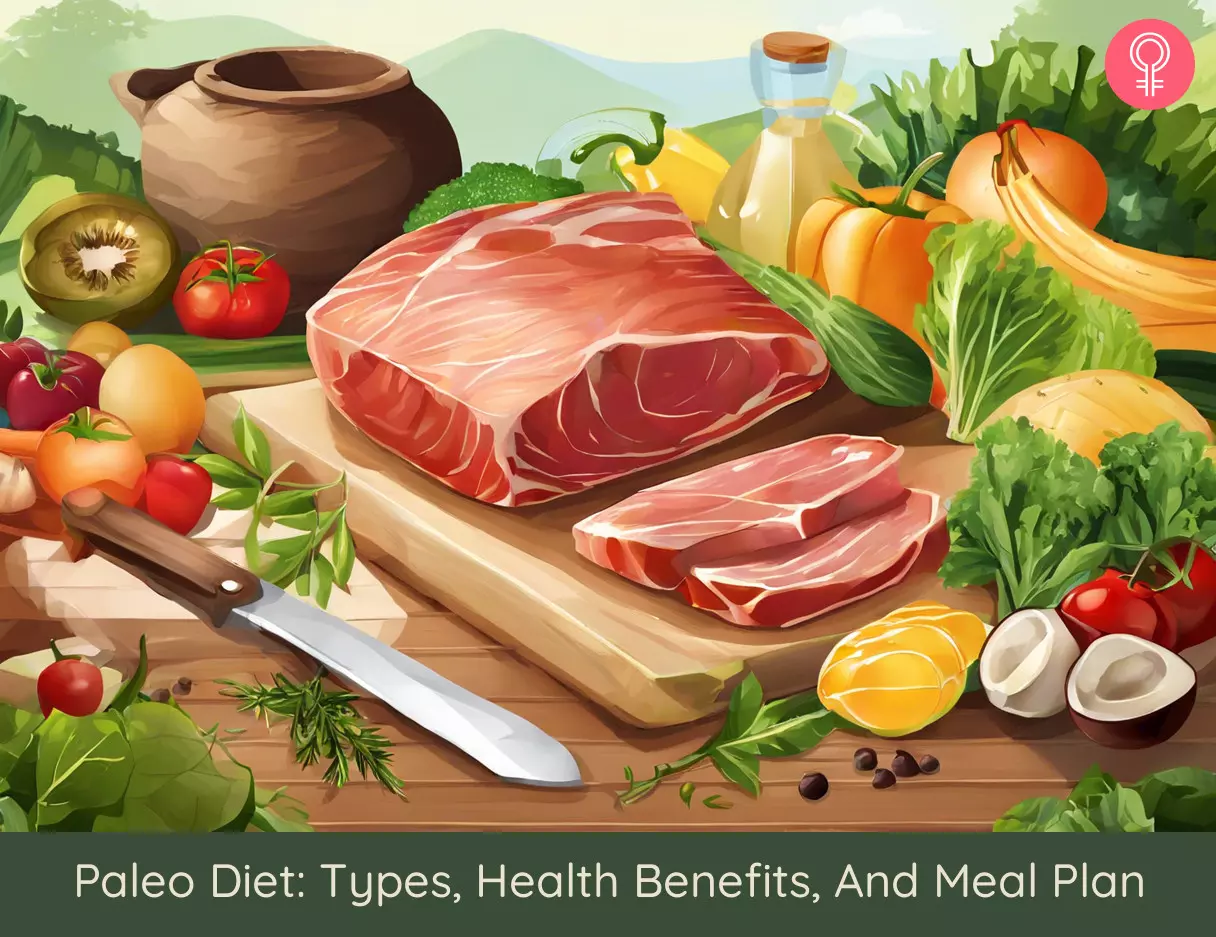What Is The Paleo Diet?
The paleo diet, also called the Stone Age diet or the caveman diet, focuses on consuming foods that may have been available during the Paleolithic age. This includes whole foods they could hunt and gather, such as fish, lean meats, fruits, vegetables, nuts, and seeds. The proponents of this diet believe that these foods may help prevent health issues like diabetes, heart disease, and obesity. It also eliminates grains, dairy, and legumes as it is believed that the human body is not fully evolved to process these foods, resulting in health issues. However, not everyone follows the diet in a very strict manner. It can be adjusted as per the individual’s requirements. Scroll down to learn about the different types of the diet.
Types Of Paleo Diet
Some people customize their diet plan as per their health goals. There are modified versions of the diet that may not be as strict as the original paleo diet. These include:
Primal Paleo Diet: This diet includes white rice, dark chocolate, fermented dairy products, raw honey, and maple syrup, as well as certain alcoholic drinks.
Normal Paleo Diet: This diet allows dark chocolate, ghee, butter, raw honey, maple syrup, and wine.
Autoimmune Paleo Diet: This is an elimination diet that involves removing foods from your diet one by one to identify the ones causing symptoms related to autoimmune diseases.
Though the diet can be adjusted as per your needs, it improves your health in various ways. Take a look.
Benefits Of The Paleo Diet
May Aid In Weight Loss
A meta-analysis found that the paleo diet may help reduce weight, BMI, and waist circumference (1). Though it is considered a fad diet, it may help in weight loss because of decreased caloric intake (2).
May Help Treat Diabetes
The reduced intake of saturated fatty acidsi A type of fat molecule found in animal products like meat and dairy, as well as plant-based oils like coconut oil and palm oil. and carbohydrates and higher intake of protein, monounsaturated and polyunsaturated fatty acids may help improve glycemic controli The regulation and maintenance of blood sugar levels within a specific target range to promote optimal health. and reduce postprandial hyperglycemiai Elevated blood sugar levels that develop after eating a meal or consuming carbohydrate-rich foods. (3). A study found that short-term adherence to this diet may increase insulin sensitivityi The body’s ability to respond effectively to the hormone insulin, which helps regulate blood sugar levels efficiently. and improve lipid profilesi A panel of blood tests that measure various types of fats (lipids) in your blood and help assess your heart health. (4).
May Help Reduce Blood Pressure
Studies suggest that the paleo diet may help lower both systolic and diastolic blood pressurei The lower number in a pressure reading that measures the force in the arteries when the heart rests between beats. due to the reduced sodium intake and weight loss (3), (5). This may help improve several cardiovascular risk factors in people with metabolic syndromei A cluster of conditions that increase the risk of coronary heart disease, stroke, and type 2 diabetes. .
May Help Improve Cholesterol Levels
Studies show that consuming a grain-free diet can lower total cholesterol, LDL-cholesteroli A type of lipoprotein that carries cholesterol in the bloodstream and contributes to plaque buildup in the arteries. , and triglyceridei A common type of fat that comes from the foods you eat and high levels of which may increase the risk of heart disease. levels (5), (6). However, the exact mechanism behind this is yet to be studied, but it is believed that a grain-free diet is lower in carbohydrate and sugar content, which are the main culprit behind LDL cholesterol. Therefore, following this diet may help manage high cholesterol levels and reduce the risk of heart issues. This diet helps improve your health in various ways but to avail its benefits, scroll down to the next section for the foods to eat and exclude from this diet.
Foods To Eat On The Paleo Diet
Fruits: Apples, plums, peaches, bananas, grapes, citrus fruits, melons, and berries. Vegetables: Cauliflower, spinach, cabbage, butter squash, sweet potatoes, broccoli, Brussel sprouts, and turnips. Meat And Seafood: Chicken, beef, salmon, tuna, pork, bacon, cod, and turkey. Eggs: Free-range, pastured, or omega-3 enriched eggs. Nuts And Seeds: Chia seeds, flax seeds, sunflower seeds, pumpkin seeds, almonds, pine nuts, pistachios, pecans, hazelnuts, Brazil nuts, macadamia nuts, and walnuts. Healthy Oils And Fats: Olive oil, walnut oil, coconut oil, flaxseed oil, macadamia oil, and avocado oil.
While these are the various foods you can eat on this diet, it is also important to know the foods you should avoid. Take a look.
Foods To Avoid On The Paleo Diet
Grains: Wheat, rye, barley, cereal, bread, and pasta. Legumes: Beans, lentils, soy flour, peanuts, peas, tofu, and soy milk. Dairy: All dairy products, including low-fat milk. Refined Or Added Sugar: Soft drinks, fruit juices, table sugar, candy, pastries, and ice cream. Vegetables: Starchy vegetables like corn, jicama, and white potatoes. Vegetable Oils: Soybean oil, safflower oil, grapeseed oil, sunflower oil, cottonseed oil, and corn oil. Highly Processed Foods: Chips, cookies, everything labeled “low fat, or with many additives, including artificial meal replacements.
Now that you know about the various foods to include and avoid, scroll down to a sample meal plan to help you get started.
Paleo Diet Meal Plan
Here is a sample meal plan to help you get started:
Paleo Diet 7-Day Meal Plan
This sample meal plan can be of great help to beginners as well as people looking to lose weight. You may also customize the paleo diet recipes based on your food preferences and goals. If you do not feel like following a strict diet, you may also choose alternatives like the keto diet. While paleo and keto are interchangeably used, they are not the same. Read on to learn about the fundamental differences between the two.
Paleo Diet Vs. Keto Diet
When comparing paleo diet vs keto diet, you will find that both share some similarities as they both promote the consumption of whole, unprocessed foods. However, they differ in the following ways. While the two diets differ in many ways, both aid in weight loss and improve your overall health. However, it is important to learn about its potential risks before starting it. Scroll down to know more.
Risks Of The Paleo Diet
The diet restricts several foods such as grains and starchy vegetables that are good sources of fiber and other nutrients. This may cause nutrient deficiencies. The elimination of dairy products may result in calcium and vitamin D deficiencies. This may result in decreased bone density and increase the risk of osteoporosisi A medical condition characterized by the weakening of bones, leading to a decrease in bone density and quality. , especially during menopause (7), (8). The diet is not sustainable for long-term adherence. Consult your physician or registered dietitian if you want to do the Paleo diet, especially for those with heart, kidney, liver, or pancreatic disease.
Should you stay on the paleo diet forever? No, the paleo diet is not recommended for long-term adherence as it may cause calcium and vitamin D deficiencies (8). Therefore, it is best to stop it after a month or two. Do doctors recommend a paleo diet? Not all doctors may recommend this diet. Anecdotal evidence suggests that a doctor may recommend it for immediate weight loss but not as a long-term solution to improve your health.
Illustration: Paleo Diet: Types Health Benefits And Meal Plan
If you are a beginner looking to shed some pounds quickly, the paleo diet might be the solution you are looking for! Check out this video for the ultimate food list and essential rules for following this diet.











